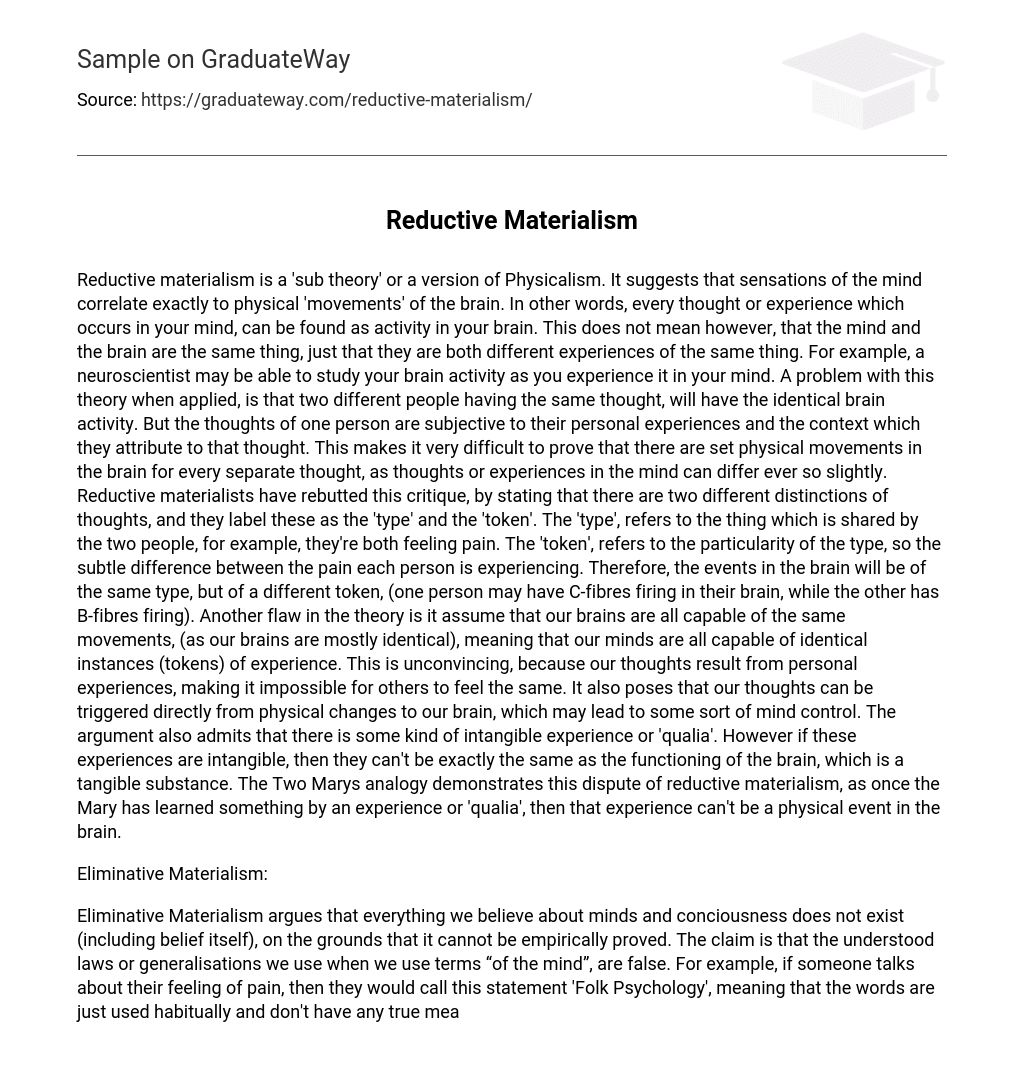Reductive materialism, a form of Physicalism, argues that mental sensations correspond precisely to physical activities occurring in the brain. This means that every thought or experience can be identified as brain activity. However, it does not imply that the mind and brain are identical; rather, they offer distinct perspectives on the same phenomenon. For instance, while a neuroscientist can observe brain activity during someone’s thoughts, applying this theory becomes challenging because two individuals having the same thought will exhibit indistinguishable brain activity. Nevertheless, an individual’s thoughts are subjective to their personal experiences and associated context, making it extremely difficult to provide evidence of specific physical movements in the brain for each unique thought since thoughts and experiences may vary slightly. In response to this critique, reductive materialists introduce ‘type’ and ‘token’ concepts to differentiate between thoughts. ‘Type’ refers to shared aspects such as both experiencing pain, while ‘token’ acknowledges the uniqueness or subtle differences in each person’s experience of pain. Consequently, brain events will be categorized as belonging to the same type but with different tokens. For example, one person may have C-fibres firing while another has B-fibres firing. The flaw in this theory lies in assuming that all brains can perform similar movements because they share mostly identical features.This implies that our minds can have indistinguishable instances. The notion that our thoughts originate from personal experiences makes it impossible for others to share the same feelings, thus undermining this concept. Additionally, it suggests that altering our brain physically can manipulate our thoughts and potentially result in mind control. The argument also recognizes the presence of intangible experiences or “qualia”. However, if these experiences are intangible, they cannot be identical to the tangible substance of brain functioning. The analogy of the Two Marys exemplifies this disagreement with reductive materialism by demonstrating that once Mary acquires knowledge through an experience or “qualia”, it cannot solely be a physical occurrence within the brain.
Eliminative Materialism:
Eliminative Materialism argues that all beliefs about minds and consciousness, including belief itself, are nonexistent because they lack empirical proof. This theory asserts that the commonly understood laws and generalizations associated with the mind are false. Instead, when we discuss mental experiences like pain, these statements are dismissed as mere habits without any genuine meaning, labeled as ‘Folk Psychology’. According to this perspective, the problem lies in the language we use to comprehend the unverifiable. However, this idea contradicts itself since it undermines belief in anything, including eliminativism. Likewise, embracing Nihilism poses a similar contradiction. Another flaw in this argument is its assumption that empirical experimentation is always accurate and consistent, which is not universally true. Additionally, some events in the physical world are not caused by physical substances. If all our beliefs and thoughts are reduced to scientific descriptions, life loses its value and emotional depth.
Biological Naturalism:
Similar to dualism, Biological Naturalism acknowledges the possibility of a non-physical state of the mind while suggesting that consciousness is an inherent aspect of our physical bodies. It proposes that consciousness has evolved alongside the brain. To differentiate between brain functions and consciousness, the terms ‘micro’ and ‘macro’ are utilized. For instance, when you stub your toe, C-fibres in your brain are activated on a micro level, while on a macro level, you experience the sensation of pain. Although this perspective lacks an explanation for how experiences at a micro level occur, it still recognizes the existence of consciousness. Consequently, this theory offers a scientific approach without requiring us to unravel the enigma of the mind – which is considered its main drawback according to John Seale who introduced this concept. He believes that further advancements in science will eventually allow us to uncover these answers.





